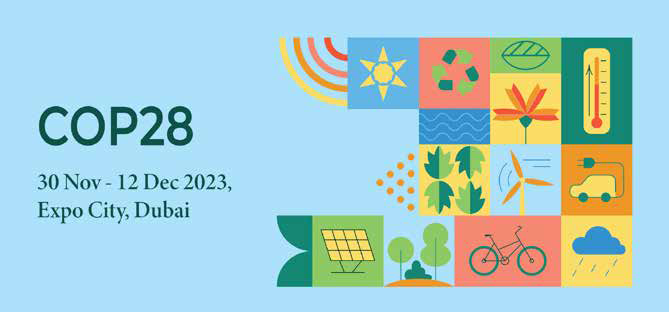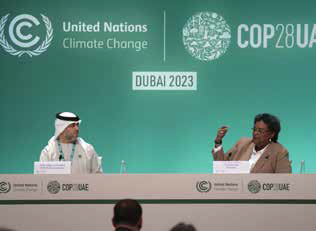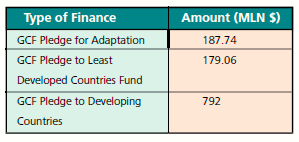
Climate change is one of the most complex issues humans are facing today. The heat-trapping greenhouse gas that is the primary cause of our recent global warming, can linger in the atmosphere for thousands of years. Responding to the climate change involves two approaches:
•Mitigating by reducing emissions and stabilizing the levels of heat-trapping greenhouse gasses in the atmosphere (“Mitigation”) •Adapting to the climate change already in the pipeline (“Adaptation”)
The United Nations (UN) Conference of Parties (COP) is responsible for the implementation of the Paris Climate Agreement drafted in 2015. COPs were traditionally limited to a small group of public sector negotiators. However, since COP28, the event has turned into a global climate meeting of political leaders, business people, sectoral experts, climate activists, as well as members of the public sector.
This article will elaborate on the decisions made in COP28, United Arab Emirates (UAE), from the 30th of November until the 13th December, 2023. The report will emphasize on different aspects of combating climate change that were discussed, as well as the achievements of the conference (COP28).
In general, the decisions made in COP28 were revolutionary, when taking into account the other 27 conferences. The fi rst Global Stock Take (GST) was drafted, with a number of developed countries Increasing their fi nancial and mitigation pledges.
The United Nations Earth Summit, held in Rio in 1992, established the UN Framework Convention on Climate Change (UNFCCC), provided a legal framework for international cooperation to combat climate change. COP is a venue for governments, climate fi nancers, United Nations, and parties most affected by climate change to reach common ground in their adaptation and mitigation policies. Article 6 of the Paris Agreement recognizes that some parties may choose to cooperate voluntarily in the pursuit of their Nationally Determined Commitments (NDCs). These NDCs include the mitigation targets of each individual country, or regional economic integration organization in the case of the European Union (EU).
During COP28, a record of 84,000 registered attendees alongside 3000 virtual participants were present. In comparison to Sharm El-Sheikh in Egypt for COP27, COP28 had twice the number of attendees. During the 14-day COP28 conference, 200 countries participated with around 20,000 civil societies, businesses, indigenous tribes, youth groups, philanthropies, universities, R&D institutions, NGOs, and international organizations.

Each day in COP28 was dedicated to a different sustainability issue. The side events and workshops also concentrated on the same daily concepts. A summary of the Important topics was presented each day for COP28 were as follows.
Stimulating Starters: The conference began with stimulating starters that set the stage for further discussions. These statements focused on the overall goals and needs for urgent climate action.
Health Day: On this day, there was emphasis on the connection between climate change and healthcare, as well as revealing the effects of climate on public health, including the need to integrate health considerations into climate policies.
Climate fi nance: The main focus was on climate fi nance, which discussed how funds are allocated and used for climate-related projects. This included discussions on the effectiveness and transparency of climate fi nance.
Youth participation: Emphasis on the importance of youth participation in climate actions. This included discussions on how to involve the youth in climate policies and activism.
Biodiversity and climate integration: The focus was on the link between biodiversity loss and climate change, emphasizing the need for policies that both conserve biodiversity and address climate action.
Canada’s Climate Initiatives: Canada announced its commitment to introduce a Federal Nature Accountability Bill in 2024. This Initiative represents the growing trend of integrating climate action with other aspects of environmental and social governance.
Artificial intelligence for climate action: The use of artifi cial intelligence in climate action, especially in the developing countries were discussed.
Agriculture and Food Day: The focus was on sustainable agricultural methods and innovation in agriculture to ensure food security against climate change.
Global Climate Action Closing Event: for the closing event, there was diligent review on the actions taken during COP28 and how they set the stage for future climate initiatives. This allowed a moment to refl ect on the progress and challenges ahead.
Negotiations and fi nal agreements: The fi nal days were dedicated to fi nal negotiations and reaching agreements. Key issues such as global review, adaptation and fi nance were likely to be at the forefront of these discussions.
COP28 Agreement: The conference ended with an agreement that signaled transitioning away from fossil fuels to sustainable energy sources.

During COP28, obstacles for developing countries to fulfi ll their climate goals included high prices of equipment as well as engineering and patenting regulations for new technologies/ technological access. During COP28, artifi cial intelligence (AI) was declared as a key for the development of climate technology in developing countries. The fl ow of climate fi nance from Global North (industrial countries) to Global South (developing countries) has been interrupted by the global credit crunch since 2020. The slow progress in the mitigation plans of the Global North in accordance with the Paris Climate Agreement was another point of discussion in COP28.
The fi rst GST was published on the 13th of December, 2023 after the conclusion of COP28. The drafted agreement with 196 paragraphs and 21 pages, stresses the most important goals as said below:
•Limiting global warming to 1.5 °C with limited or no overshoot
•Reduction in global greenhouse gas emissions by 43% in 2030 and by 60% in 2035 in comparison to the level from 2019
•Reaching net zero carbon dioxide emissions by 2050
•Limiting global warming to 1.5 °C with no or limited overshoot
•Reduction in global greenhouse gas emissions by 43% in 2030 and by 60% in 2035 relative to the 2019 level
•Reaching net zero carbon dioxide emissions by 2050
•Tripling the renewable energy capacity globally
•Doubling the global average annual rate of energy effi ciency by 2030
•Accelerating efforts towards the down phase of unabated coal power

•Accelerating efforts globally towards net zero emission energy systems, utilizing low and zero-carbon fuels well before or by the mid-century
Transitioning from fossil fuels in energy systems with a just, orderly and equitable manner, as well as accelerating action in this critical decade, the goal to achieve net zero by 2050 in keeping with the science
•Accelerating zero and low-emission technologies, including: renewables, nuclear, carbon capture and utilization and storage system, and low-carbon hydrogen production
• Reducing methane emissions by 2030
• Reduction of emissions from road transport by the deployment of low and zero-emission vehicles
•Phasing out ineffi cient fossil fuel subsidies that do not address energy poverty Such a report recognized that parties are not collectively on track towards achieving the Paris Agreement. The NDCs must, on average, reduce global emission by 2% compared to the 2019 level in 2030. Some countries, due to the economic circumstances and the need to import sustainable technology, can raise greenhouse gas emissions with a limit of 2 degrees Celsius.
The main fi nancial tool for combating climate change in developing countries is the Green Climate Fund (GCF). This fund concentrates on the needs of societies that are highly vulnerable to the effects of climate change, particularly least developed countries (LDCs), small island developing states (SIDS), and the African states. The Global Public Sector (GST) reported that the global climate fi nance requirements by 2030 is $5.8 to $5.9 trillion. The GST climate fi nances in 2021 was $89.6 billion. The 31 contributors of the Green Climate Fund have pledged $12.8 billion. The GST have also indicated the following fi nancial data:

According to the fi rst GST, the total amount of adaptation fi nances needed by the developing countries is $215-387 billion per year by 2030. In addition, the total clean energy fi nance by 2030 is estimated as $4.3 billion a year and by 2050 estimating at $5 billion a year.
Contrary to the fears circulating around the potential costs of net zero, the research provided emphasizes on the economic growth potential of the energy transition projects. Nonetheless, vast funding gaps remain, with high upfront capital needs, low short-term yields, and uncertain longerterm market conditions, all concepts that raise the investors’ risks.

During the fi rst day of COP28, the United Arab Emirates as well as BlackRock and Brookfi eld participated in the launch of a $30 billion fund to invest in climate-related projects. This newly launched catalytic climate vehicle is called ALTÉRRA. This private fi nancial vehicle aims to mobilize $250 billion, globally, by 2030.
In addition, during COP28, another $500 million was raised from different commitments on Special Drawing Right, water scarcity and health for African youth. $1.2 billion in investments were raised (mainly by) the US and China in order to contribute to the reduction of methane gas by 10 million tons, within the span of 5 to 7 years.
•12 NGO’s, $450 million for 3-years of methane reduction projects, in which proposals need submission
•UAE government assistance of $200 million dedicated to South Sahara Africa and South Asia Loss and Damage as a result of climate disasters
•For Brazil, 205 million was provided for reforestation of 60,000 square kilometers of Amazon
•The UAE and some NGOs provided $777 million for tropical health issues
• Eight donor governments announced new commitments to the Least Developed Countries Fund and Special Climate Change Fund totaling over $174 million
•Low emission electrolysis hydrogen in refi neries
•Development of E-fuel
•The UAE and some NGOs provided $777 million for tropical health issues
• Eight donor governments announced new commitments to the Least Developed Countries Fund and Special Climate Change Fund totaling over $174 million
The COP19 established the Warsaw International Mechanism for Loss and Damage associated with Climate Change Impacts (Loss and Damage Mechanism). This fund addresses loss and damage associated with impacts of climate change in developing countries that are particularly vulnerable to the adverse effects of climate change.
On the first day of COP28, $100 million was raised for the Loss and Damage Fund to help the world’s poorest and most vulnerable countries hit by climate catastrophes. The UAE and Germany allocated this fund.
The total loss and damage funding, which will be managed by the World Bank, approximates to $429 million. The following are pledges for the fund during COP28:
•$245 million from European Union
•$75 million from the United Kingdom
•$24.5 million from the USA
•$10 million from Japan
During COP28, 38 companies and 6 industrial associations endorsed the Industrial Transition Accelerator. The Poznan Strategic Program (PSP) and the Global Environment Facility (GEF) of UNFCCC provided funding for climate technology transfer activities.
The Industrial Transition Accelerator will function under the PSP, focusing on the following climate technologies:
•The use of AI for climate action in Small Island Developing States and Least Developed Countries
•Disaster warning automation systems
•Use of biodiesel and natural gas in shipping The use of internet (for whatever means necessary) for household appliances
•Low emission electricity generation for renewables and nuclear purposes
•Carbon Capture Utilization Storage systems
•Low emission electrolysis hydrogen in refi neries
•Development of E-fuel
The process of phasing out fossil fuels was not fully addressed in COP28. Press reports indicated that prior to the conference, the Emirates Oil Company signed a contract worth $17 billion for the development of the Al Hail and Ghasha gas fields.
During COP28, The UN Secretary General Antonio Guterres said: “We cannot save a burning planet with a fi rehose of fossil fuels, the 1.5-degree limit is only possible if we ultimately stop burning all fossil fuels. Not reduce. Not abate.” Regardless, COP28 only asked for the transition away from fossil fuel rather than phaseout. In addition, OPEC members simultaneously asked to disclude language phaseout in the fi rst GST draft.
COP28, as it failed to address fossil fuels, failed to address the phasing out of coal as well. The statement “rapidly phasing down unabated coal and limiting permits” in the original GST draft was undermined by making “efforts towards the phase down of unabated coal power.”
Each day of COP28 covered a different aspect of climate change, from high-level policy discussions to specifi c topics such as health, fi nance, technology, water, and agriculture. The main topics addressed during the conference were technology and innovation, inclusion, environment resilience, front line communities and finance.
Although the language phaseout was not used for fossil fuels, the majority of experts believed COP28 signifi ed the “beginning of the end” for the era of fossil fuel usage. This was concluded when COP28 laid the ground for a swift, just, and equitable transition, underpinning deep emissions cuts and scaled-up finance.
Agreement on the world’s first GST was reached to keep the global temperature limit of 1.5°C within reach. GST is considered the main outcome of COP28, as it contains every element that was under negotiation and can now be used by countries to develop stronger climate action plans due by 2025. In COP28, there was progress on the loss and damage agenda with an agreement that the UN Office for Disaster Risk Reduction and the UN Office for Project Services will host the secretariat of the Santiago Network for Loss and Damage. This platform will catalyze technical assistance for developing countries that are particularly vulnerable to the adverse effects of climate change.
Climate finance took the center stage at the conference, where the GCF received a boost to its second replenishment with six countries pledging new funding at COP28. However, as highlighted in the GST, these financial pledges are undoubtedly short of the trillions eventually needed to support developing countries with clean energy transitions, implementing their national climate plans and adaptation efforts. The new financial goal will begin from a baseline of $100 billion per year for GCF investment.
COP28 also observed parties agree to Azerbaijan as host of COP29 from the 11th to the 22nd of November, 2024, and Brazil as the COP30 host from the 10th to the 21st of November, 2025. It is expected that COP29 will urge governments to establish a new climate fi nance goal, similarly at COP30, the parties must come prepared with new NDCs fully aligned with the 1.5°C temperature limit.
Opening Hours:
24/7
Address: Tradex Mena International Consulting Group L.L.C-FZ 6th Floor, Business Center, The Meydan Hotel Grandstand, Meydan Road, Nad Al Sheba, Dubai, United Arab Emirates
+971 50 240 9735
Address: TRADEX INTERNATIONAL CONSULTING DANIŞMANLIK
itH. iHr. ve TiC. LTD. ŞTi.
Tomtom Mah. istiklal Cad. Beyoğlu iş Merkezi No.187 iç Kapr No: 4 Beyoğlu/iSTANBUL Beyoğlu V.D. 8591125255